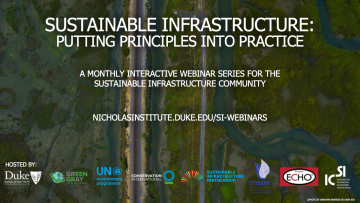
On 13 October 2021, this webinar in the Sustainable Infrastructure: Putting Principles into Practice series will explore Avoiding Environmental Impacts and Investing in Nature, Principle #4 from UNEP's International Good Practice Principles for Sustainable Infrastructure.
- Exchange state-of-the-art knowledge on how to plan and build sustainable infrastructure;
- Participate in an interactive forum to learn from other practitioners as they present case studies, including best practices and pitfalls; and
- Connect with a community of individuals and organizations engaged in the sustainable infrastructure sphere.
Technical and case study presentations will focus on one of ten principles from UNEP’s International Good Practice Principles for Sustainable Infrastructure:
- Strategic Planning
- Responsive, Resilient, and Flexible Service Provision
- Comprehensive Lifecycle Assessment of Sustainability
- Avoiding Environmental Impacts and Investing in Nature
- Resource Efficiency and Circularity
- Equity, Inclusiveness, and Empowerment
- Enhancing Economic Benefits
- Fiscal Sustainability and Innovative Financing
- Transparent, Inclusive, and Participatory Decision-Making
- Evidence-Based Decision-Making
This session starts with an introduction to Principle #4, followed by an introduction to the Global Standard for Nature-based Solutions (NbS), which equips users with greater clarity and precision of what the concept entails and what is required for it to be deployed successfully. The remainder of the session includes the presentation and discussion of a case study to make the business case for investment into a nature-based green-gray infrastructure alternative to highway widening in coastal Colombia. The session included interactive activities that allowed exchange between case study presenters and participants regarding sustainability challenges and lessons learned.
Go to webinar recording
Hosted by: Sustainable Infrastructure Partnership, Duke University Nicholas Institute for Environmental Policy Solutions, the Green Gray Community of Practice, UN Environment Programme, Conservation International, ITTECOP, and Project ECHO
